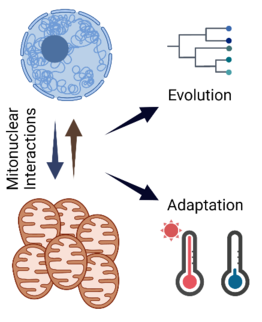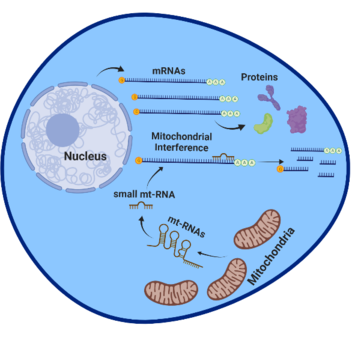Andrea Pozzi - Mitonuclear Interaction Evolution
Mitochondria in evolutionary biology
 Mitochondria are ubiquitous organelles whose best-known function is the production of energy through ATP synthesis. They are often referred as the “powerhouse of the cell”, however, research accumulated in the past decade suggests that mitochondrial function might not be limited to energy production. These organelles have their own genome, and by studying the genetic variation in these genomes across natural populations, researchers have found that mitochondrial mutations can affect important life-history traits such as survival and fertility. For example, several recently published experimental studies on strains of Drosophila melanogaster having the same nuclear-haplotype but different mitochondrial haplotypes have demonstrated that just a few mutations in the mitochondrial genome affect the capacity of flies to tolerate extreme thermal stress. The mechanism underlying this effect is currently unknown and discovering this mechanism is one of the main goals of the group.
Mitochondria are ubiquitous organelles whose best-known function is the production of energy through ATP synthesis. They are often referred as the “powerhouse of the cell”, however, research accumulated in the past decade suggests that mitochondrial function might not be limited to energy production. These organelles have their own genome, and by studying the genetic variation in these genomes across natural populations, researchers have found that mitochondrial mutations can affect important life-history traits such as survival and fertility. For example, several recently published experimental studies on strains of Drosophila melanogaster having the same nuclear-haplotype but different mitochondrial haplotypes have demonstrated that just a few mutations in the mitochondrial genome affect the capacity of flies to tolerate extreme thermal stress. The mechanism underlying this effect is currently unknown and discovering this mechanism is one of the main goals of the group.
What are the mitonuclear incompatibilities?
A necessary step in the speciation process is the creation of a reproductive barrier, impeding the conception of offspring between individuals originally belonging to the same species. Mitochondrial mutations are important in postzygotic reproductive isolation, as specific mutations can affect the viability of hybrids across populations. For example, the best-known case of hybrid incompatibility involving mitochondrial products in yeast has been discovered in hybrids of Saccharomyces cerevisiae and bayanus. In these two species, the interaction between an NU-protein and a mitochondrial rRNA is necessary for the correct functioning of the mitochondria, however, when hybrids are formed, the new pair of mitochondrial protein and mitochondrial rRNA do not interact properly and cannot support the production of energy in the mitochondria. Another example has been found studying hybrids of S. cerevisiae and uvarum. While most hybrids between S. cerevisiae and S. uvarum are fitter than their parental strains, the growth of the strains depends on the temperature and which MT-genome they inherited. The hybrids with the MT-genome from S. cerevisiae grow better at high temperatures, while hybrids with the MT-genome from S. uvarum have higher growth at lower temperatures. These examples highlight the important of mitonuclear interactions for adaptation and speciation, however, we still do not know how the MT-genome can exert such effects. For this reason, we are now exploring one hypothesis that could explain how the mitochondrial genome influences these phenotypes.
The mitochondrial interference hypothesis
 The mitochondrial interference hypothesis proposes that the small mitochondrial RNAs use the RNAi mechanism to modulate nuclear gene expression, changing the organism's phenotype. RNAi is a process in which a miRNA leads a protein complex to block the translation of a target mRNA. The sequence of the miRNA is usually partially complementary to a regulatory region of the target mRNA, and the miRNA uses the affinity of these complementary sequences to guide the protein complex to its target mRNA, hindering the binding of the ribosome to the mRNA. The RNAi is involved in the regulation of many genes (~60% of the genes in mammals) thus if the mitochondria can use RNAi through the small mitochondrial RNAs, then the range of functions that the mitochondria can have would increase dramatically. These functions could affect both adaptation and speciation by affecting phenotypes such as fertility or thermal adaptation.
The mitochondrial interference hypothesis proposes that the small mitochondrial RNAs use the RNAi mechanism to modulate nuclear gene expression, changing the organism's phenotype. RNAi is a process in which a miRNA leads a protein complex to block the translation of a target mRNA. The sequence of the miRNA is usually partially complementary to a regulatory region of the target mRNA, and the miRNA uses the affinity of these complementary sequences to guide the protein complex to its target mRNA, hindering the binding of the ribosome to the mRNA. The RNAi is involved in the regulation of many genes (~60% of the genes in mammals) thus if the mitochondria can use RNAi through the small mitochondrial RNAs, then the range of functions that the mitochondria can have would increase dramatically. These functions could affect both adaptation and speciation by affecting phenotypes such as fertility or thermal adaptation.
Why working on yeast?
The fission yeast, S. pombe, is among the best organisms to investigate mitochondrial incompatibilities and identify the underlying mechanism. The choice of a single-cell organism bypasses complex tissue-specific pattern of expression of the small mitochondrial RNAs of metazoa, and among the single-celled organisms, fission yeast is probably the best for this project. This species is usually haploid, reproducing asexually through sporulation, increasing the strength of co-adaptation between nuclear (NU) and mitochondrial (MT) genes, as MT-genes can interact only with one copy of NU-genes. This phenomenon suggests that mitochondrial incompatibilities would have stronger effects in this species than in other diploid species (S. cerevisie) where nuclear mutations can ‘hide’ in recessive state.
Students can find the opportunities available for thesis or research internship on the group page:

